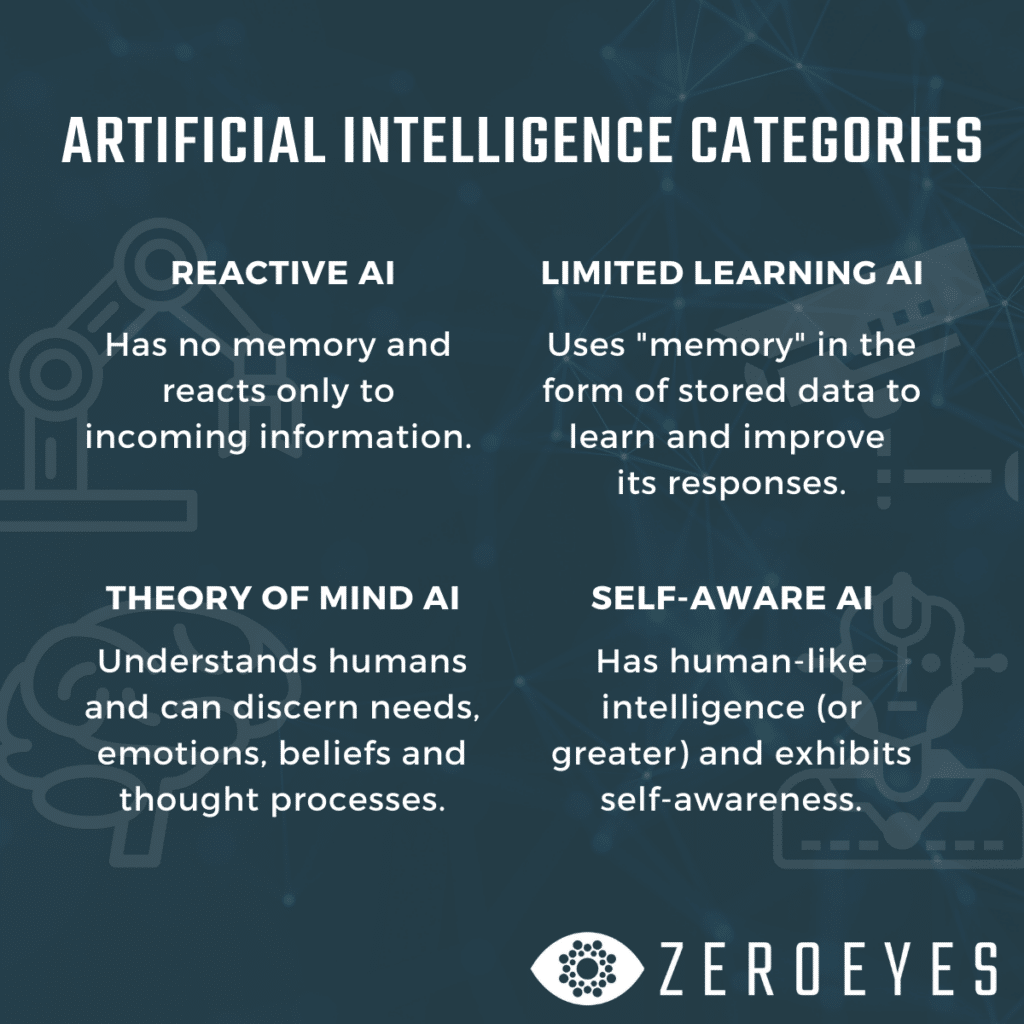Part 1 of our AI Security Blog Series
We’ve all heard the term artificial intelligence (AI) – but few of us know what it really means. That’s because artificial intelligence can encompass everything from Amazon’s Alexa and Google Search to sci-fi androids straight out of the movies. Like “big data,” artificial intelligence is an umbrella term for things like machine learning, deep learning and neural networks, and that’s just the tip of the iceberg. However, those technical terms leave us with even more questions than answers and may have you wondering if all this technology is truly better than human intelligence in the long run.
Let’s take a 30,000-foot view at what artificial intelligence is to give us a better understanding of the technology involved.
Artificial Intelligence Defined
Dating all the way back to 1956, artificial intelligence has been defined as “the science and engineering of making intelligent machines,” by John McCarthy, professor emeritus of computer science at Stanford.
Today, AI is a wide-ranging branch of computer science concerned with building smart machines capable of performing tasks that typically require human intelligence.
These AI algorithms attempt to mimic human intelligence through deep learning and machine learning (we’ll get to that in a future post).
“Artificial intelligence is a set of algorithms and intelligence to try to mimic human intelligence. Machine learning is one of them, and deep learning is one of those machine learning techniques.”
Frank Chen, Venture Capitalist
Artificial intelligence is divided into four categories: Reactive Machines, Limited Memory, Theory of Mind and Self-Aware. Let’s define these types of AI.

Type I: Reactive Artificial Intelligence
Has no memory and reacts only to incoming information.
Artificial intelligence that’s classified as reactive is just that – its software designed to react to outside stimuli. It has no memory and can’t “learn,” meaning it can’t take information from previous experiences and apply problem-solving capabilities to future performance.
This is the oldest and most remedial form of AI and has historically been useful for mimicking basic human-like functions that respond to a limited set of inputs. A positive element of reactive AI is that these machines will react exactly the same way each time they are in the same situation, making them reliable and trustworthy for repetitive tasks.
Example: The most famous example of reactive AI is IBM’s supercomputer Deep Blue, which beat chess Grandmaster Garry Kasparov in 1997. Deep Blue was able to take all the information from the chess board at the moment and compute future moves based on the odds of success. It didn’t rely on past information for the decisions and didn’t plan out future moves ahead of the most current move on the board – it was purely reactive.
Type II: Limited Memory Artificial Intelligence
Uses “memory” in the form of stored data to learn and improve its responses.
Nearly all present-day AI machines fall into the category of limited memory. Unlike reactive AI, limited memory AI uses huge amounts of data stored in its memory to create predictions for solving problems. Limited memory AI is trained (by developers) to take the data, understand the contents of it, and attach that information to all other input data it scans. By attaching stored data to new data it’s presented with, limited memory AI machines can learn, labeling new data with ever-improving accuracy.
For this to work, teams of developers must follow a process to create the software:
- Create training data
- Create the machine learning model
- Enable the model to make predictions
- Allow the model to receive outside input
- Allow the outside input to be stored as data
- Repeat as a cycle
That means a limited memory AI machine can look into the past (through its stored data) to make predictions about the future. This type of AI is only as good as the data it’s given. Every time developers feed it new data sets and create new models, the AI functionality increases.
Limited memory AI has its constraints. When it comes across input data that it can’t match to its data library, it will hit roadblocks. These outlying situations need human input to create new data models that the machine can use and learn from, which is why the process of developing this AI is a continuous cycle.
Example: Again, limited memory artificial intelligence is the most used type of AI today. Image-scanning software is a perfect example of this – it uses data from the previously scanned images and models in its memory bank as a reference. As it scans new images, it looks at the data models to find a match. If it scans an image that it can’t find a match for, it hits a roadblock, and developers need to create new models for the AI to reference.
Self-driving cars, Amazon’s Alexa, Google Search and chatbots are all examples of limited memory AI – along with ZeroEyes’ DeepZero™ weapons detection software.
The DeepZero AI utilizes an extensive, labor-intensive trial-and-error process that involves testing databases of hundreds of thousands of images and videos, rather than relying on online footage. From there, a comprehensive dataset is constructed to continuously train the AI weapons detection model for improvements.
Type III: Theory of Mind
Understands humans and can discern needs, emotions, beliefs and thought processes.
While the first two categories of AI have been created and we continue to improve upon them, the next two categories are entirely theoretical – hence the title of category III: Theory of Mind.
While experts believe we’ve hit a wall in developing AI, the leap from existing limited memory AI to intelligence that can understand humans and can discern needs, emotions, beliefs and thought processes will eventually be a major breakthrough. This theory of mind AI will essentially have a mind of its own and will be capable of learning with fewer data models, delivering personal experiences based on each person’s motivation.
Type IV: Self-Aware
Has human-like intelligence (or greater) and exhibits self-awareness.
Like theory of mind AI, self-aware AI is the stuff of Hollywood. This category of AI will be aware of their existence, will be able to make abstractions and will be emotionally intelligent. Self-aware AI will have motivation of its own and will make decisions based on its own agenda and thought processes without the need for human intervention.
Why is Artificial Intelligence Important?
Artificial intelligence allows us to go beyond simple industrial machinery to create intelligent systems that support human endeavors. While we’re at the cusp of a new era in AI technology, it’s important to keep in mind that AI should augment human intelligence rather than replace us altogether. Our next blog post will dive deeper into some of the mechanics of artificial intelligence, including machine learning, deep learning and neural networks. In the meantime, learn more about our practical AI for weapons detection, DeepZeroTM.

